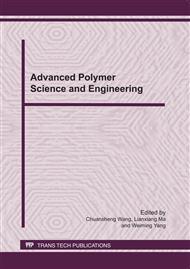p.200
p.205
p.211
p.216
p.221
p.228
p.235
p.240
p.247
Research on the Curing Behaviour and Morphology of an Epoxy/OMMT Nanocomposite System
Abstract:
The curing behaviour of an epoxy/OMMT nanocomposites system which was composed of a bifunctional epoxy resin with an anhydride curing agent and OMMT was investigated. Differential scanning calorimetry (DSC) was used to investigate the curing behaviour of the nanocomposites system. As for the nanocomposites system containing different amounts of OMMT, the values of activation energy, reaction order, theoretic gelling temperature and theoretic curing temperature were evaluated by kinetic equations. And the effect of OMMT on the curing reaction and the curing reaction mechanism of the system were discussed. The results showed that the curing process is at 100°C for 1hr, 170°C for 2hr when the OMMT content is 3%. XRD was used to observe the interlayer spacing of the OMMT and SEM was used to survey the morphology of nanocomposites system.
Info:
Periodical:
Pages:
221-227
Citation:
Online since:
March 2011
Authors:
Keywords:
Price:
Сopyright:
© 2011 Trans Tech Publications Ltd. All Rights Reserved
Share:
Citation:


